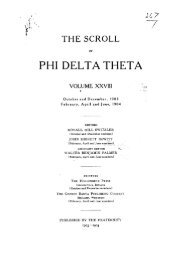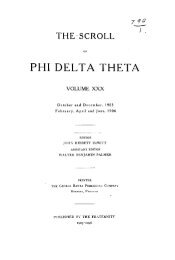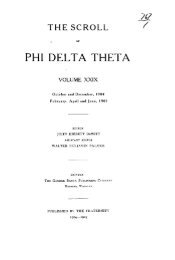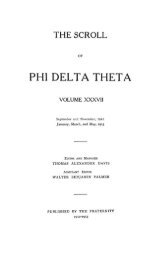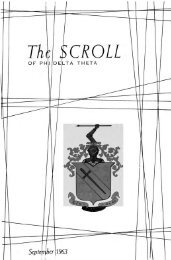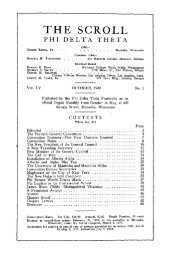1953–54 Volume 78 No 1–5 - Phi Delta Theta Scroll Archive
1953–54 Volume 78 No 1–5 - Phi Delta Theta Scroll Archive
1953–54 Volume 78 No 1–5 - Phi Delta Theta Scroll Archive
Create successful ePaper yourself
Turn your PDF publications into a flip-book with our unique Google optimized e-Paper software.
A Corner With <strong>Phi</strong> Authors<br />
Recent Additions to the David D. Banta<br />
Memorial Library (*)<br />
•kfinancing Higher Education in the United<br />
States by JOHN D. MILLETT, DePauw '33. Columbia<br />
University Press. 1952.<br />
Here is a careful analysis of the over-all<br />
administrative and financial conditions and requirements<br />
of higher education today. John D.<br />
Millett, the author, was executive director of the<br />
Commission on Financing Higher Education,<br />
which devoted three years of intensive study to<br />
the major problems now facing the colleges,<br />
universities and professional schools of this<br />
country. Dr. Millett here summarizes and interprets<br />
the research staff's findings. Financing<br />
Higher Education in the United States is a<br />
book that every educator needs; everyone who<br />
cares about the future of higher education in<br />
the U. S. also needs to know this book.<br />
The book has five parts: The Objectives of<br />
Higher Education, Costs and Administration,<br />
Sources of Income, Possibilities for Future<br />
Financing, and The Task Ahead. In the first<br />
part. Dr. Millett gives the facts about programs,<br />
student bodies, and the organizational structure<br />
of higher education. He evaluates the scope<br />
and the development of pur colleges and universities<br />
to date.<br />
Costs and Administration, the second part, is<br />
a comprehensive, factual; and revealing picture<br />
of the cost trends in higher education. Factors<br />
in educational costs, administrative costs, special<br />
cost problems, internal organization and management,<br />
cooperation among institutions, capital<br />
plant needs, and expectations are all discussed.<br />
The third part. Sources of Income, describes<br />
and interprets current operating income, including<br />
student fees, endowment income, state<br />
and local government support, private benefactions,<br />
federal government support, and general<br />
income. In this section, Dr. Millett reviews<br />
past experience with these various sources of<br />
support.<br />
In Possibilities for Future Financing, Part IV,<br />
Dr. Millett focuses on how income for higher<br />
education may be increased in the future. He<br />
analyzes the income needs of higher education,<br />
and discusses in detail the probable futiue of<br />
student charges, state and federal government<br />
support, and private benefactions.<br />
Finally, Dr. Millett assesses the total picture<br />
of the financing and the status of higher education<br />
in United States.<br />
[101]<br />
Careful, sound, authoritative, unusually perceptive,<br />
challenging, this book is a tool for the<br />
use of everyone who must make the decisions<br />
about the future of higher education.<br />
* w *<br />
"kNature and Needs of Higher Education by<br />
JOHN D. MILLETT, DePauw '33. Columbia University<br />
Press. 1952.<br />
This brief book sweepingly surveys the whole<br />
field of education in the American democracy,<br />
outlining its character and pointing out its problems.<br />
It centers particularly on the crucial issues<br />
that face administrators in securing financial<br />
support for changing times and policies. The<br />
suggestions offered for difficulties are discussed<br />
practically. Concliisions are firm and clear-cut.<br />
The Commission on Financing Higher Education,<br />
after three years of intensive study, offers<br />
its final report in brief compass in Nature and<br />
Needs of Higher Education. Eight college and<br />
university administrators and four laymen who<br />
are trustees of various institutions made up this<br />
distinguished group. In unanimous agreement,<br />
this Commission set forth a program of action<br />
needed to preserve and strengthen higher education<br />
as the bulwark of our free society.<br />
A sample of the forthright conclusions is: "But<br />
the great financial need of higher education<br />
cannot be met by whatever economies may be<br />
effected internally by colleges and universities.<br />
<strong>No</strong>r should it be met by federal subsidy: our<br />
opposition to this we have emphatically recorded."<br />
Nature and Needs of Higher Education<br />
tells how these important educators believe<br />
that our institutions of higher learning<br />
may be financed in the future.<br />
Sound, authoritative, concise, here is a<br />
summary of higher education in the United<br />
States that every thinking person will want.<br />
* • •<br />
•kCurtain Time (Four one act plays) by<br />
C. H. KEENEY, Oregon '22. Exposition Press,<br />
New York, 1953.13.<br />
Brother Keeney, a successful West Coast<br />
author, has turned his hand to playwriting, and<br />
the result is a collection of four plays that are<br />
particularly well suited to production by aipateur<br />
groups and theatrical companies who must<br />
operate on a small budget. Mr. Keeney, who<br />
resides in Whittier, Calif., has concentrated on<br />
topics that have a proved audience appeal.<br />
Old "Skin"-Flint, the first play in "Curtain<br />
Time," deals with the machinations of a



